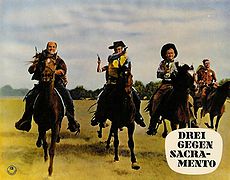Duello nel Texas - Gringo (Review Scherpschutter)

|
Cast:
Director:
Cinematography:
Music:
|
Duello nel Texas - Gringo (Gunfight at Red Sands)
View Database Page | Available DVDs | Duello Nel Texas - Special

|
A key movie in the history of the genre. It was the first western produced by Jolly Films, the production company of Arrigo Colombo and Giorgio Papi, who would also produce, one year later, A Fistful of Dollars. For this reason this is often called the first spaghetti western. European westerns preceding it, were either predominantly Spanish or had not enough characteristic elements to be labeled as a spaghetti western. The movie was co-written and co-produced by the mysterious Albert Band/Alfredo Antonini, a recurring name in the early days of the genre. Two other people behind the scenes of this oater would make a considerable contribution to Leone’s movie: cinematographer Massimo Dallamano (‘Jack Dalmas’) and composer Ennio Morricone (‘Dan Savio’). The two movies were also supposed to share the same lead actor, but Richard Harrison turned down the offer to appear in A Fistful of Dollars.
It’s nice to see that the this pre-Leone western, is already set in and around an American-Mexican border town. Still a co-production with Spain, the location was probably chosen to ‘explain’ the look of the Spanish cast members and extras. But this location also gave the screenwriters the opportunity to add a few anti-racist touches to the story. Harrison plays 'Gringo Martinez', a white man who was adopted as a child by a Mexican family now living north of the border; he has left the heard of the family and crossed the border to help the poor in the Mexican Civil War. Coming home, he discovers that his father was killed and the family gold stolen. His adopted brothers has seen the three men responsible for the crime, but Mexicans have become second-rate citizens in Texas, and the sheriff is unwilling to investigate the case …

|

|
Duello nel Texas is a transitional movie, if ever there was one: it still has a traditional western flavor to it, but it’s seasoned, at the same time, with both the anti-racist sentiments of the Karl May movies an the blood-calls-for-blood philosophy of the Italian western. Harrison’s character of a white man sympathizing with people who are subjected to racial prejudice, seems a far echo of May’s Old Shatterhand, but the murder of the foster father, inevitably turns him into a spaghetti western avenger. The film also has the typical line-up of villainous businessmen and dignitaries, that would become a recurring genre element, just like the gorgeous, but not entirely blameless saloon lady, played by a voluptuous Latin beauty, the spaghetti western equivalent of the Southern Belle. With a giggling henchman and even a dash of Zapata (while on Mexican soil), the film almost seems an ouverture to the genre, offering virtually all characteristics in a nutshell.
Duello nel Texas was directed by the relatively unknown Ricardo Blasco, who had worked for television and - as assistant-director - on a series of Zorro movies. Some of the town scenes, with lovely señoritas showing their bare shoulders and clear-skin smiles while flirting with passers-by, are quite good, but apparently he didn’t know how to handle action scenes, so Mario Caiano was flown over to Spain to do them. Caiano spent five or six days in the company of cinematographer Dallamano (1), and looking at those action scenes, it wouldn’t surprise me if Dallamano had a directional hand in them too. The final duel with Harrison and Rossi-Stuart is a typical main street duel, with odd angles and close-ups, closer to what Dallamano would do with Leone than what Caiano would do himself in Pistols Don't Argue, his next project for Jolly Films.
If the film offers virtually all genre characteristics in a nutshell, but also in some sort of rudimentary, imperfect form. It’s set in a border town, but the town is full of life, not a ghost town. There are no creaking doors or steps, no whining dogs, no howling winds (2). Harrison is not a cynical loner, but a gentleman like hero, a loving son and brother, and Rossi-Stuart looks very much like one of the many rocks stars of the moment who were dreaming of becoming the local Elvis. Morricone’s score is a rather classical one, supporting the movie’s action rather than illustrating it. The theme song, A Gringo like Me, is nice, but also more than just a bit cheesy. In many ways we’re almost there, but it took a magician to make it all click. The final duel is okay, but instead of a ritual build-up in the style of Leone, which would give Morricone the opportunity to flog up the tension with his whips, whistles and trumpets, it is preceded by one of those chaotic gunfights with a lot of stuntmen falling – aaaaarghhh – from great heights.
Related Page:
Notes:
- (1) Marco Giusti, Dizionario del western all'italiana
- (2) The town looked so different that I didn't recognize it when watching the movie. But the town scenes for Duello nel Texas were shot in Hoyo de Manzanares, near Madrid, in the same western town Leone would use for A Fistful of Dollars http://www.western-locations-spain.com/madrid/hoyo_de_manzanares/index.htm
German Lobby Cards
--By Scherpschutter






